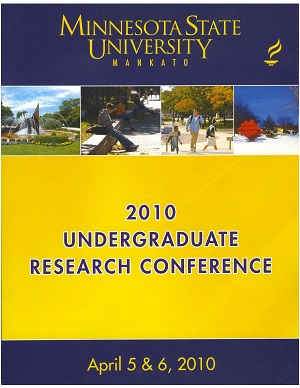Common Word Use in Adolescents with Williams Syndrome and their Typically Developing Peers
Location
CSU 253/4/5
Start Date
5-4-2010 1:00 PM
End Date
5-4-2010 3:00 PM
Student's Major
Speech, Hearing, and Rehabilitation Services
Student's College
Allied Health and Nursing
Mentor's Name
Patricia Hargrove
Mentor's Department
Speech, Hearing, and Rehabilitation Services
Mentor's College
Allied Health and Nursing
Description
This project investigated use of common words in adolescents with Williams syndrome. Williams syndrome is a developmental disability characterized by cognitive impairment and unique strengths and weaknesses in language skills. Speakers with William syndrome ―have quite extensive and strong, language expression and acquisition. However, the ability to speak those words, in addition to complications with visuo-spatial recognition, can be impaired. What is commonly seen, then is a child with advanced vocabulary and a keen skill for grammar, with a poor ability to express speech and a poor ability to perform in areas that involve abstract thinking‖ (Cadena, 2007).
Our research is focused on semantic/vocabulary distinctions between adolescents with Williams syndrome (WS) and their typically developing peers (TDP). Specifically, we examined conversations for three hundred of the most common words in English, ranked in order of frequency. The first one hundred words make up about half of all written material, and the first three hundred make up about sixty-five percent of all written material.
We reviewed speech samples of twelve adolescents with WS and twelve TDP from a pre-existing database. The reviewers were not informed about the status (WS or TDP) of the participants. We calculated the relative frequency of the three hundred words for each of the participants.
The results will be discussed in light of the current literature on William syndrome.
Common Word Use in Adolescents with Williams Syndrome and their Typically Developing Peers
CSU 253/4/5
This project investigated use of common words in adolescents with Williams syndrome. Williams syndrome is a developmental disability characterized by cognitive impairment and unique strengths and weaknesses in language skills. Speakers with William syndrome ―have quite extensive and strong, language expression and acquisition. However, the ability to speak those words, in addition to complications with visuo-spatial recognition, can be impaired. What is commonly seen, then is a child with advanced vocabulary and a keen skill for grammar, with a poor ability to express speech and a poor ability to perform in areas that involve abstract thinking‖ (Cadena, 2007).
Our research is focused on semantic/vocabulary distinctions between adolescents with Williams syndrome (WS) and their typically developing peers (TDP). Specifically, we examined conversations for three hundred of the most common words in English, ranked in order of frequency. The first one hundred words make up about half of all written material, and the first three hundred make up about sixty-five percent of all written material.
We reviewed speech samples of twelve adolescents with WS and twelve TDP from a pre-existing database. The reviewers were not informed about the status (WS or TDP) of the participants. We calculated the relative frequency of the three hundred words for each of the participants.
The results will be discussed in light of the current literature on William syndrome.
Recommended Citation
Wallin, Emily and Jessica Wandrie. "Common Word Use in Adolescents with Williams Syndrome and their Typically Developing Peers." Undergraduate Research Symposium, Mankato, MN, April 5, 2010.
https://cornerstone.lib.mnsu.edu/urs/2010/poster-session-B/2



